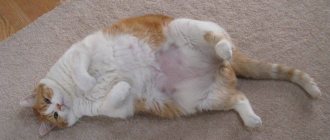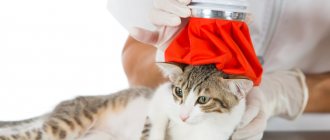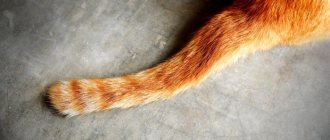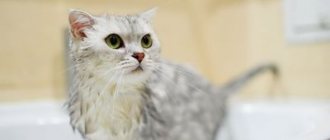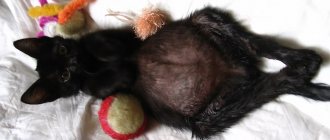8500Administration
3
Urinary incontinence in a cat, which owners often perceive as hooliganism on the part of the animal, is actually a sign of a health problem in a furry or hairless pet. To eliminate this unpleasant phenomenon, the cat must receive high-quality medical care, for which it should be shown to a veterinarian. If this is not done, the disease that caused the incontinence will continue to progress and may lead to the death of the sick cat. Provided that therapy begins in a timely manner, the likelihood that the problem will be eliminated completely is very high.
A cat has urinary incontinence: 6 main reasons
Urinary incontinence in cats, otherwise known as incontinence, occurs for the following reasons:
- Spinal injuries. They occur as a result of falling from a height or being bitten by a dog. Alternatively, tumors in the immediate vicinity of the spinal cord.
- Obesity develops in domestic cats as a result of adynamia. Neutered men suffer most often.
- Cystitis is inflammation of the bladder. They develop when an infection enters the urinary tract.
- Urolithiasis (UCD) occurs as a result of cystitis or metabolic disorders, mainly in cats due to the peculiarities of the anatomical structure of the urinary canal. The main reason is poor nutrition combined with hypothermia.
- Kidney pathologies. Typical for older animals.
- Diabetes.
Causes of the disease
Uncontrolled urination in a cat is not an independent disease, but a symptom of a pathology of a neurogenic nature, structural anomalies of the urinary system, functional disorders or psycho-emotional stress.
The main reasons why a cat began to urinate not in the tray, but in the wrong places, include the following:
- Infections in any part of the urinary system.
- Congenital anomalies of the genitourinary system.
- ICD (urolithiasis). Constant irritation of the sphincter leads to the fact that urine is not retained in the ureters and bladder.
- Metabolic disorders associated with diabetes, obesity. Urine is usually excreted in droplets.
- Damage to the brain or spinal cord due to trauma, hypertension, inflammatory processes.
- Old age of the pet. In old age, all body systems can no longer cope with their functions, muscles weaken, which leads to urine leakage.
- Frequent childbirth. A cat that gives birth more than once a year does not have time to recover its urinary system, which disrupts the normal functioning of the bladder. This leads to persistent incontinence.
- Spasm of the bladder muscles. Urine is excreted once.
- Paralysis of the lower body and limbs. The cat urinates constantly.
- Injuries and damage to the bladder. Various degrees of urination.
- Oncology and benign tumors in the bladder and urethra.
- Surgical intervention (including castration), during which the nerve endings were damaged.
Sometimes the problem of uncontrolled urine output can be encountered after a cat has had a catheter inserted. This phenomenon goes away after a few days on its own without treatment.
Finally, the cause of uncontrolled urine output is often the stress that the cat has experienced - a change of place of residence, a large number of guests in the house, the appearance of another pet, etc.
Complex therapy
If the disease was caused by disorders of the nervous system, then a comprehensive solution to the problem will be required. The veterinarian finds out the reasons that caused malfunctions in the spinal cord and brain. Based on the data obtained, therapy is carried out.
Sometimes the treatment provided does not bring the desired results. This situation is possible if the breeder turned to a doctor for help too late, or the pet is already too old.
Treatment
Once the cause of urinary incontinence is discovered, your veterinarian will be able to prescribe the correct treatment for your cat.
Treatment methods for urinary incontinence depending on the disease that caused it:
- If infection is present, antibiotics must be used;
- To treat incontinence due to problems with excess weight, dietary adjustments and physical activity are required;
- If there are problems with the cat's nervous system, the pet should be carefully examined to determine the factors that led to health problems.
In some cases, treatment may not have a positive effect. As a rule, this statement applies to elderly cats. In order to avoid unpleasant moments associated with constant incontinence in a cat, you need to place trays in different places in the house or put a special diaper on your pet. It is also recommended to cover furniture and carpets with oilcloths for a while until the animal’s urine output returns to normal. In any case, it is not recommended to use any incontinence medications on your own, as this can lead to disastrous consequences. Very often, to diagnose a problem, an ultrasound of the cat’s internal organs is used and tests are performed that confirm or refute the diagnosis.
If your cat's urinary incontinence is caused by extreme stress, childbirth, or trauma, it may improve without medication. But in this case, proper care for the animal is simply necessary.
It is prohibited to use human incontinence products to treat a cat.
This decision will not help the cat, and will also significantly worsen its condition.
Since enuresis causes severe stress in the animal, the owner must make every effort to surround the cat with attention and care. This attitude towards your pet will definitely have a positive effect on the effectiveness of treatment.
You should not throw your cat outside or physically punish him. Despite the unpleasantness of the situation, a person must understand that incontinence is a disease, and not a whim or whim of an animal.
Types of urinary incontinence in cats
There are the following types of urinary incontinence in cats:
- Leakage : The sphincter fails to control the flow of urine. Urine constantly flows or is released in drops. They are absorbed into the carpet or sofa fabric and are invisible. Pathology is detected by the presence of an ammonia odor. The intensity of the leakage increases when the animal moves.
- Stress : joy or fear is accompanied by involuntary urination.
- Urinary urgency occurs suddenly. The animal does not have time to get to the tray, worries that an embarrassment has happened to it, but is unable to do anything.
Be sure to read: A cat often burps: causes, symptoms, what to do when vomiting after eating, prevention, what not to do
Symptoms of urinary incontinence in cats
Signs of uncontrolled urination in cats are easy to spot. They are directly related to the reasons why the cat began to urinate more often than usual. As a rule, this is constantly wet fur on the inside of the thighs, on the stomach and under the tail, wet spots in the places where the pet has just sat or stood.
INTERESTING TO KNOW: Causes of deafness in cats
Embarrassment can happen at any time: both in a dream and during wakefulness, when the pet does not have time to run to the toilet. In this regard, the behavior of the animal changes. A cat, which is naturally clean, realizes that it has peed in the wrong place and becomes depressed and frightened. And if the owner also begins to violently express indignation at what happened or punish the pet, then another problem will be added to one problem - a stressful state.
When the disease is infectious, the cat urinates and experiences pain. The pet begins to meow pitifully. And a paralyzed cat, which walks on its own, does not even understand that its urine is released voluntarily.
Defecation disorders
The nature of the disturbance in the defecation process depends on the level at which the spinal cord was damaged:
- In some cats, food begins to move through the intestines more slowly than it should.
- In others, the functioning of the rectal sphincters is disrupted.
- Some animals simply stop feeling the impulses coming from an overcrowded intestine. They don't strain their abdominal wall to poop; the anal sphincter remains contracted.
- And very rarely there is complete fecal incontinence.
If you are not satisfied with the situation in which the cat poops on its own, but unpredictably (feces fall out while the animal moves around the apartment), you can take control of the defecation process. To do this, the rectum is stimulated with a finger, which causes its reflex emptying.
The owners' task is to ensure that the pet poops at least once every 2-3 days, and that the feces remain soft enough.
How to control urinary incontinence? Tips for a spinal specialist
There are four systems functioning in our body, with the help of which we take from the environment what we need and excrete what we do not need. With the help of our lungs, we inhale air, absorbing mainly oxygen from it, and exhale carbon dioxide. With the help of our skin, we decompose the rest of the air (carbon dioxide and some other chemicals) and excrete it through sweat. But the main filters of our body are the stomach and intestines, with the help of which we remove all solid matter (excrement), and the kidneys, which serve to remove waste products of liquid breakdown (urine).
In spinal cord injuries, paralysis affects these systems. The biggest problems occur in the kidneys, the urethra (the tubes leading from the kidneys to the bladder) and the bladder. If paralysis of the bladder occurs, it is impossible to feel when it is full, and we cannot release it at our will, as is usually done.
Lack of bladder control is often a cause of depression in people who have just suffered a spinal cord injury. They begin to feel helpless and insignificant. However, it is important to remember that in most cases, paralyzed people can learn to control their incontinence without experiencing the slightest difficulty or discomfort, and no one will be able to guess that they have this deficiency.
Learning to control urinary incontinence means learning to take care of the urinary system, because paralysis of the bladder contributes to contamination of the urine in it. The infection can spread from the bladder to the kidneys, and then there is a danger that they will stop functioning and remove harmful substances from the body. Well, if these substances are not removed, there is a mortal danger. Paraplegics and tetraplegics are more likely to die from kidney infection than from any other cause.
HOW TO ACHIEVE YOUR BLADDER RELEASE REGULARLY
So, now it is clear that it is vitally important for you to prevent infection of the urinary system. When paralysis has just set in, the doctor will take care of it. It probes the bladder under completely sterile conditions.
However, after being probed three or more times a day for several weeks, you should learn to empty your bladder on your own. It's not difficult, although, like everything new, it requires a little practice. There are different ways. You can choose the one that suits you best. If you have a low spinal cord injury, you can press your hand on the lower abdomen to free the bladder. With an upper injury, it is better to find some urge that causes the bladder to be released reflexively, for example, lightly patting the lower abdomen, rubbing the skin in this area or in the groin, pressing on the perineum - the area located in front of the anus.
Whatever method you use, you need to get to the point where you empty your bladder at the same time and do not urinate for at least four hours. Later, you will learn to regulate your fluid intake so that you can empty your bladder at the time that works best for you. Remember, however, that you need to completely release it three or four times a day. For example, if you work, you can empty your bladder in the morning, say at 7:30 a.m., and drink something before leaving the house. Then, during tea breaks (at about 10 a.m. and 4 p.m.), you can empty your bladder again and drink. Around 7 p.m., you drink your last drink of the day, making sure that your bladder is completely empty by the time you go to bed.
All people with spinal cord injuries should drink plenty of fluids (about two liters a day) to flush out the kidneys, bladder and urethra. The fact is that the kidneys now do not function as efficiently as before the damage, and if you do not drink enough fluids, then decay products accumulate in them, which can cause infection or the formation of stones. The liquid can be different and suit your tastes: water, fruit juice, tea, soup... A glass of beer a day will also not hurt, but not in large quantities, avoid, as already mentioned, alcoholic beverages. The alcohol contained in one large glass, once in the blood, harms the kidneys, and you need to keep them in the best possible condition.
If you don’t want to have to go to the toilet extra times during your night shift, then don’t drink anything a few hours before and empty your bladder before leaving the house.
Do not forget, when you are at home, to drink especially generously once in order to compensate for the lack of fluid during the time that you are forced to spend without drinking.
HOW TO LISTEN TO URGINGS
When a healthy person needs to urinate, he has certain sensations in the bladder, and he does not need other signals coming from other parts of the body. Although you may not directly feel that your bladder is full, you can pay attention to other notifications your body is sending. Some people experience headaches, flushing, or a stuffy nose when their bladder is full; others sweat profusely; some may even start vomiting. When any of these urges appear, you must immediately empty your bladder.
WHEN YOU SHOULD SEEK A DOCTOR'S HELP
If you can't empty your bladder, you probably have what's called retention. It can be complete or partial. Urinary retention causes unpleasant consequences, which is why you need to act immediately, at the first signal. If you wear a urine bag, check to see if anything is blocking the tube or if your posture is making it difficult for you to pass urine (you probably already know the best position for emptying your bladder). Try changing your position: if you were sitting, lie down; if you were lying down, sit up and try to empty your bladder again. If this still does not help, you will have to call a doctor so that he can take the necessary measures. Initially, the doctor will use conventional methods (pressing or patting the abdomen, etc.) to trigger the reflex action. If this does not produce an effect, then very carefully, using a mask, sterile gloves, two tweezers and four napkins, he will insert a very thin rubber or plastic probe into the bladder through the external hole. When the doctor is sure that the bladder is completely empty, he will remove the probe. If there is a significant infection, the doctor will use a Foley probe with a small ball at the end. The ball is blown into the bladder and prevents the probe from slipping out. Such a probe must be changed every three days, and if there is a temporary delay, if the infection has resolved after rinsing and antibiotics, it must be removed and dried well.
HOW TO USE ACCESSORIES
Some are unable to avoid urinating for long periods of time. In this case, there are other forms of solving the problem of incontinence.
It's easier for men. They may use a urine bag, a device that fits over the penis and collects urine, which flows through a tube into a plastic bag attached to the leg. When you are dressed, no one will notice that you are wearing it. If you use a urine bag, check it frequently to ensure it is in place correctly to avoid chafing the skin and causing ulcers on the penis and scrotum.
There is still no urine bag that would be convenient for women, so a woman with a spinal cord injury, as a rule, uses diapers and plastic tights. Diapers should be durable, soft and absorb moisture well, and tights should not rub the skin anywhere. Women who use diapers are concerned that those around them will smell an unpleasant odor. This can be avoided by changing diapers frequently, washing thoroughly (three or four times a day) and using talcum powder every time. These hygienic precautions will also avoid irritation that may occur if diapers are not changed frequently. A good way to prevent irritation is to place a piece of linen fabric on the front side of the diaper, facing the skin. This fabric will absorb moisture from the diaper and keep the skin dry.
Even if you don't need to constantly use a urine bag or diapers, these methods may be very useful in some cases, for example, when traveling when there is no accessible toilet.
For some men and women, the best way to deal with urinary incontinence is with a Foley tube, which we already mentioned. This is a tube with a ball that is inserted into the bladder and, when inflated, remains inside it. The urine flows through a tube into a plastic bag. The Foley tube needs to be changed two to three times a week, otherwise it can cause bladder stones. There are already more modern modifications of probes that should be changed only once every three weeks - these are the Seilastic probes. Ask your doctor about these long-lasting tubes. If it becomes necessary to use a permanent tube, the hospital will teach you how to handle it and how to change it after a period of time. If you have an upper spinal cord injury and there is no one to help at home, then a nurse or local doctor will do everything necessary. It is very important to make sure that the tube and bag are completely sterile to prevent infection from entering the bladder. In addition, you need to keep in mind: whatever the position you are in, you should place the probe in such a way that it cannot cause ulcers in the urethral area (where the ureter exits the bladder to the outside); Make sure that the tube is not compressed or clogged anywhere, this will prevent urine from flowing into the collection bag.
Source: I. Apolikhina. The quality of life. Prevention. No. 5 September - October 2003
What to do if your cat has urinary incontinence?
Sometimes urinary incontinence occurs as a postpartum complication. The pathology resolves spontaneously. In all other situations, if incontinence is suspected, the cat is sent to the clinic for examination.
The veterinarian conducts an examination, takes blood for analysis, performs an ultrasound, makes a diagnosis and prescribes treatment. If surgery is indicated, it is performed in a clinic, and postoperative care is provided by the animal owner at home. If conservative treatment is required, follow the procedures prescribed by the veterinarian.
With urolithiasis, situations arise when it is necessary to insert a catheter to drain urine. If your cat is diagnosed with diabetes, you will need insulin therapy and a special diet that is low in carbohydrates and high in protein and fat.
What to do
Enuresis in cats is a complex disease that needs to be treated only after identifying the causes that caused it.
Treatment is prescribed by a doctor based on medical history, clinical, laboratory, and instrumental studies. Often, ultrasound, x-ray of the pelvic area, and biochemical blood tests are prescribed for diagnosis.
Some owners give their pets medications designed to treat incontinence in humans. This is strictly prohibited! Such a decision will only worsen the cat’s condition.
There is no single treatment regimen for enuresis in cats; therapy is complex and is developed individually for each case. The doctor determines the dosage and duration of taking specific medications.
Depending on the stage of the disease and the cause of the pathology, the following are prescribed:
- antibiotics, antimicrobial agents - for infectious disease;
- adjusting nutrition, ensuring physical activity - during weight gain;
- restorative drugs;
- painkillers and antispasmodics - for urolithiasis;
- drugs that increase the tone of the bladder walls and improve sphincter function, but they give a temporary effect.
It is not uncommon for cats to be catheterized for enuresis. The choice of catheter is carried out in strict accordance with the individual characteristics of the animal (each breed has its own nuances).
If a tumor is detected, treatment is surgical followed by rehabilitation.
It should be noted that problems with urination can go away on their own if the factors contributing to their occurrence are eliminated. For example, if enuresis occurred in a cat after giving birth or was the result of severe stress, then with good care it will go away without the prescription of medications. During treatment, it is recommended to cover upholstered furniture and carpets with oilcloth.
INTERESTING TO FIND OUT: Is it possible to cure distemper in cats?
If urinary incontinence in cats is associated with old age, then it is hardly possible to correct it. There is nothing you can do, the most you can do is put a diaper on the animal or place trays throughout the apartment.
The owner must be patient and provide the patient with the best possible, high-quality care so that he feels comfortable at home. If a cat pees in the wrong place, this is not a reason to punish him or kick him out of the house; on the contrary, the patient should understand that he is safe.
Diagnostics in a veterinary clinic
To make a diagnosis, the veterinarian, in addition to a visual examination of the animal and anamnesis, conducts a number of diagnostic studies. These include urine analysis, blood biochemistry, pelvic x-ray, and urological ultrasound. Sometimes additional diagnostic methods are used.
Urine for analysis must be collected correctly, otherwise feces caught in the urine may affect the results of the study.
It is advisable that the material for analysis be taken directly by a specialist.
Urinary incontinence in cats: treatment at home
Recovery after surgery consists of treating surgical sutures and a gentle diet. Conservative treatment consists of eliminating the underlying disease. The therapeutic strategy includes dietary therapy and drug treatment.
Correcting the diet eliminates factors that provoke urinary tract irritation. All human food products are excluded, as well as treats containing waste from cutting meat and fish.
The veterinarian will tell you when you can adjust the composition of the natural diet, and in which cases you can use ready-made dietary food. In some cases, therapeutic nutrition is carried out until the clinical symptoms disappear, but sometimes lifelong use of ready-made dietary feeds will be required.
Medications
Medicines are used to eliminate the symptoms of the underlying disease.
The following groups of medicines are in demand:
- antibiotics;
- antispasmodics;
- anti-inflammatory drugs;
- analgesics;
- means that normalize the functioning of the sphincters and bladder.
Be sure to read: Diarrhea in a kitten: what to do, first aid, causes, treatment, medications and folk remedies
To improve the well-being of older animals with chronic renal failure, the oral remedy Semintra or analogs are prescribed.
Folk remedies
There are no traditional medicines that can have a positive effect in the treatment of urinary incontinence. However, the many years of experience of connoisseurs of medicinal herbs have been taken into account and, on its basis, drugs have been developed that are used in medicine and veterinary medicine. Urolex contains birch leaves; bearberry. goldenrod, horsetail.
The drug is used to treat urolithiasis, as well as inflammatory processes of the urinary tract 3 times a day for a month. The drugs Kot Erwin and Stop-Cystitis have a similar effect.
Medicines developed on the basis of traditional medicine can be used after consultation with a veterinarian.
Diagnosis of chronic renal failure in cats
Diagnosis of chronic renal failure begins with anamnesis (medical history) and a clinical examination of the cat by a veterinarian. If, based on clinical signs, a doctor suspects a diagnosis of chronic renal failure, he must confirm it using laboratory tests.
Monitoring the patient’s blood and urine parameters is very important not only for making or confirming a diagnosis, but also for identifying additional problems in the body - mineral imbalance, anemia, and the presence of signs of a bacterial infection.
Monitoring the level of urea and creatinine, calcium, phosphorus before, during and after treatment allows you to objectively assess the severity of the problem and the effectiveness of treatment.
The use of diagnostic methods such as ultrasonography (ultrasound) and x-rays also makes sense to identify renal and postrenal causes of chronic renal failure, such as urolithiasis, polycystic disease, neoplasia (tumor growth) and others.
Treatment method and prognosis
In case of involuntary urine discharge, complex treatment is carried out. The scheme is drawn up individually, depending on the cause of the pathology, age, and condition of the animal.
The main treatment methods include:
- Antibiotic therapy. Relevant for identifying infections and bacteria in the genitourinary system. The drug is administered intramuscularly or intravenously.
- The use of medications to normalize metabolic processes in the body.
- Special diet (if the pet is overweight).
- Antispasmodics and painkillers (for urolithiasis).
- Drugs that strengthen the tone of the bladder walls and stimulate the activity of the sphincter.
The prognosis depends on the disease. So, if incontinence is associated with an infection in the body, then after appropriate treatment it goes away.
Unfortunately, in some cases it is no longer possible to get rid of this unpleasant disease. If the cat is old, then its weakened body cannot adequately respond to therapeutic measures. In addition, the tissues are not restored and rejuvenated, so urine will leak constantly and its volume will increase.
The only thing that remains for the owner to do is to come to terms with it and provide the pet with the most comfortable living conditions. You can place trays in different places in the apartment or put a diaper on the cat.
Diagnostics
Since the causes of urinary incontinence are very wide, and treatment will depend on it, diagnosis is necessary. First of all, this is an examination by a veterinarian, taking an anamnesis; depending on the cause, an ultrasound of the bladder and a general clinical urine test are most often required.
There are two main groups of pathologies in which leakage or incontinence of urine can be observed - these are neurological pathologies, when nerve conduction is impaired, as a result of which the cat cannot control urination, and various diseases that cause pain or impede the patency of the urinary tract - cystitis, urolithiasis, obstruction, and so on.
Neurological pathologies can be associated with spinal trauma (very often in cats after a fall from a height or in those hit by a car). If the damage has been severe and the conduction of the spinal cord is completely disrupted, there is no cure and the cat will always have problems urinating. In this case, the type of damage will depend on the nature of the injury - the damage can be of the type of upper or lower motor neuron (this depends on the level where the brain is damaged). If the cat is damaged by the type of upper motor neuron, there will be a complete absence of urination; in these cases, it is vital for the animal to manually push down to help them empty the bladder. If this is not done, the bladder quickly overflows, stretches, and becomes atonic—as a result, urine can leak, giving the impression that the animal is incontinent, or flow out in puddles, which is why owners often think that the cat is still urinating independently. If an animal is left with such damage for a long time, constant overflow of the urinary tract will cause cystitis, ascending inflammation, and death from renal failure.
When the lower motor neuron type is damaged, urine constantly leaks from the bladder. For such cats, constant wearing of a diaper is necessary.
If it is known that the animal has had a spinal injury, or has undergone surgery to stabilize the spine, an examination by a neurologist is recommended. Also in these cases, in addition to treating the immediate problem of urinary incontinence, you can contact a rehabilitation doctor for help to improve the quality of life.
Preventing urinary incontinence in cats
Preventing pathology involves following the rules for keeping and feeding a cat. There should be no drafts in the room. The cat should not be bathed frequently, and if such a need arises, it should be thoroughly dried and allowed to dry before being released indoors.
It is necessary to decide on feeding - natural or ready-made food. You cannot alternately feed both. If you decide to change the type of feeding, this should be done gradually, over the course of a week.
The use of economy-class feeds unbalanced in amino acids and vitamins accelerates the development of chronic diseases that lead to inflammatory processes in the genitourinary area and urinary incontinence. Therefore, it is necessary to use ready-made food of at least premium class. The use of canned food and granules can be alternated.
Neutered animals should be fed prepared food for sterilized cats. Excess gonads alter metabolic processes and increase susceptibility to the formation of urinary stones. Sterilization at an early age causes the urinary ducts to stop growing and they remain narrow.
If urate salt precipitates, a grain of sand is formed. In animals with a normal width of the ureter, it skips. With a narrowed lumen, the stone gets stuck. An obstruction to the outflow of urine is formed. Urolithiasis (urolithiasis) develops.
Be sure to read:
What to do if the kitten cannot poop, how can you tell if the cat is constipated?
Additional diagnostics will be required to prescribe treatment. If struvite stones have formed, urine acidifying foods will be required. When oxalate stones are detected, the urine must be alkalized by selecting feed. Cats are transferred to specially developed medicinal food.
For pets predisposed to KSD, it is recommended to use bottled still water for drinking. Treats from the table must be stopped. Products that are unusual for cats contain substances that provoke the development of chronic diseases.
Obese cats are transferred to ready-made dietary food. If you limit the consumption of natural food, your pet will feel hungry and scream, begging for food. Diets for overweight animals contain a high percentage of dietary fiber, which limits consumption. The pet's body will receive fewer calories, but the animal will feel full.
Medicinal food has been developed for cats suffering from kidney disease, diabetes, and urolithiasis. However, a cat cannot be protected from one disease. This is old age. Older pets are switched to specialized food that allows them to feel satisfactory.
Prevention
Preventing urinary incontinence in a cat is quite a difficult task due to the fact that urine can leak due to many factors. However, veterinarians still give some recommendations to prevent the problem:
- high-quality pet feeding;
- timely treatment for worms;
- prevention of uncontrolled presence of a cat on the street;
- refusal of cheap ready-made economy-class feed.
By providing the pet with quality living conditions, the owner reliably protects the cat from pathologies and injuries that cause urine leakage.
When, for some reason, a cat’s incontinence is discovered unexpectedly, and when it arose is unknown, it is necessary to show her to a specialist as soon as possible. Her health cannot be ignored because of the risk of dangerous and serious complications of the condition.
Anyone who has a cat knows how careful they are with their personal hygiene, especially when it comes to using their litter box properly. When a cat has poor hygiene, it is a clear sign that something is wrong, whether it is intentional or not.
Preventive measures
In order to prevent the occurrence of enuresis in a pet, it is important to exclude all factors and causes that have a positive effect on the development of this pathology. It is important to feed your cat properly and prevent injuries, falls and bruises. There should be no drafts or excessively low temperatures in the room where the cat is located.
Systematic examinations by a veterinarian for preventive purposes are the best way to prevent urinary incontinence and any other disease in a pet.
What are the reasons?
Determining the cause of urinary incontinence can be difficult because it is a common symptom of various conditions and diseases. Among them we can mention:
- Old age: In cats over 10 years of age, incontinence may simply be a sign of old age, as the tissues are not strong enough to control the sphincters.
- Spaying or neutering: Due to the hormone suppression, estrogen or testosterone, these procedures involve, your cat may lose control of her urine.
- Kidney stones in the bladder.
- A tumor in the bladder: constantly pressing and causing an endless desire to urinate.
- Congenital deformities: The bladder or urethra is not located where it should be. This appears during the first year of life.
- Diseases such as feline leukemia or diabetes.
- Urinary infections: such as cystitis, cause an urgent urination that the cat cannot satisfy due to the discomfort of the disease.
- Stress caused by changes in the cat's routine (moving, arrival of a child or other pet, etc.).
- Injury to the pelvis, hip, or spine from a fall or a very strong blow that affects the nervous system.
- Obesity.
- Overactive bladder syndrome.
- Neurological problem.
Movement
Even with irreversible damage to the spinal cord, some cats can develop what is called a spinal gait. With such a gait, the movements of the hind legs are not controlled by the brain, walking is a reflex and there is no pain sensitivity. The back moves awkwardly and wobbles a lot, but does that really matter since the cat can walk on its own!
If spinal gait cannot be achieved, cats still move quite deftly using their pectoral limbs. It should be noted that injury to paralyzed paws is rare. But if the owners notice abrasions and scuffs, they put on socks or special soft shoes.
Experts warn: you need to help your pet as little as possible. It seems cruel when a cat tries to climb onto the sofa over and over again. It’s much easier to pick her up and place her where she needs to be. But this is a disservice: if the cat understands that there is no need to try, he will expect help and will stop developing new skills. Don't bring a paralyzed animal breakfast in bed, force him to be active - and you will be amazed at the results.
You can adapt the apartment with additional steps, or cover slippery areas with carpet. Cats need a multi-level space that is fun to crawl around. It is very important to regularly play with a paralyzed cat as you would with a normal pet.
A frequent question from owners: do they need a stroller or walker? This recommendation cannot be general. Strollers are especially important for dogs, and cats do not always agree to use them. Moreover, the wheels will not help you climb onto your favorite sofa, but will only get in the way. It's definitely worth experimenting. Typically, the animal spends a limited amount of time in the walker, chasing a toy or laser pointer, after which the structure is removed. If the back of the walker's paws drag on the floor, they are protected with soft covers.
Causes of urinary incontinence
Neurogenic
Caused by a malfunction of the nervous system, which can occur from injuries, tumors and hernias in the spine or brain. Nerve endings are pinched or ruptured, so their conductivity is disrupted.
Structural anomalies
They can be congenital (hypoplasia, ectopia), acquired (urethral and bladder stones, formation of urethrovaginal fistulas, etc.).
Functional disorders
Occur due to diseases affecting the functions of the excretory system. So, with urinary tract infections, inflammation of the walls of the bladder and urethra occurs, so the contractile activity of the bladder is disrupted, it becomes hyperactive.
With stones, tumors of the bladder, kidneys, adrenal glands, acute urinary retention may occur in a cat. Cystitis and nephritis are also accompanied by urination problems.
Factors such as proper pet maintenance, feeding regimen, and lack of stress are very important. Too fatty or spicy foods make the urine more alkaline, which can lead to itching, burning of the urethra, and inflammation of the upper parts of the urinary system. Therefore, it is strictly forbidden to feed an animal with food from our table.
